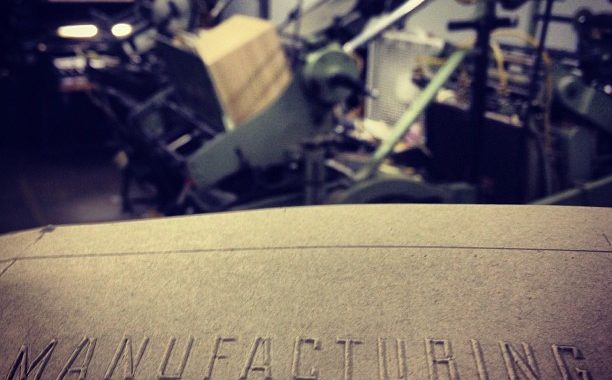Transcript:
Both of these words are letterpress terms, this is a letterpress machine we use in printing, it describes the terms embossing and debossing as the pushing of paper to a level that is different to the original level of the actual paper. Both of these terms are used in offset and/or digital printing.
It’s basically done with a die and a cutter die. This would be a die and this would be the cutter die. These two things fit inside each other. The paper is actually squeezed between them and we apply heat.
The die is mounted on the platen and the cutter die is mounted on the offset platen and this machine basically sits there and opens and shuts. It is basically a clamshell type press.
Embossing is basically where you push the level of the image up above the original level of the paper so, embossing, another way to look at it will be as if you are walking along on the ground and all of a sudden you have to step up, that’s embossing.
Debossing would be when the cutter die actually pushes the image down below the original surface image on the paper. So, again, in uses of the terms, if you are walking along and all of a sudden fall in a hole, that’s debossing.
We do this by using dies. Again this is a die and this is a cutter die and that is what is going to raise or lower the image that we are using on the sheet. There are different materials that we can use for the dies. This is actually a brass die; this is by far the most durable, also the last longest. You are going to use this if you’re doing multilevel , if you are in a situation when you can be doing something over and over, or you have a long run. Brass would be the next level, and copper would be the next level down. It is less expensive, would not stand up to quite as many impressions but it is still a pretty durable type of die. The die that you can use for shorter run type things is a magnesium die. You are only going to be able to do a single level and it’s gonna be more like a one-use type of die.
You heard me talking about multilevel and single level: Multilevel would be if you are actually trying to do a 3D image, like if you are trying to embossed somebody’s face, you want the nose to be one level, cheeks to be another, ears to be another level so you can see that 3D effect. That’s multilevel. Single level would be if we are trying to emboss just a line of type, or a logo, and we are just trying to raise it up to one level.
We also use heat in conjunction with embossing and debossing. So, basically we can iron the texture of the paper out to get more contrast between the actual original level of the paper and the emboss or deboss level.
Talking about papers, there are a couple of types of paper that we would use: You have coated and uncoated and there are some considerations that you need to use in both those papers.
On coated, it has a clay coating. You are not going to be able to emboss quite as deeply. Basically, what it means is that before you actually come through that clay coating, you got to keep it to a lower level.
On uncoated paper you can emboss much deeper, you can do more multilevel type embossing, that kind of things, so you have a lot more flexibility on uncoated or textured type paper.
Hope this helps in understanding the differences between embossing and debossing as it applies in printing. If you need any more information, you can contact us via the form.
You will find more info about paper embossing at:
- This Wikipedia article.
- This printpromotionguide.com article.
